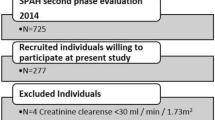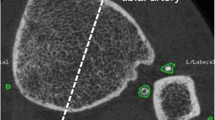Abstract
Summary
In this study, high-resolution peripheral quantitative computed tomography (HR-pQCT) was used to investigate geometric, volumetric and microstructural parameters at the distal radius and at the distal tibia in participants with ischaemic heart disease. We found that, compared with participants without ischaemic heart disease, they had substantially lower cortical volumetric bone mineral density (BMD) at the distal radius.
Introduction
HR-pQCT captures novel aspects of bone geometry and volumetric bone mineral density (vBMD) and offers the ability to measure bone microarchitecture, but data relating measures obtained from this technique in patients with ischemic heart disease (IHD) are lacking.
Methods
Here, we report an analysis from the Hertfordshire Cohort Study, where we were able to study associations between measures obtained from HR-pQCT of distal radius and distal tibia in 350 participants (184 men and 166 women) aged 71.5–80.5 years with or without IHD (e.g. heart attack, angina or heart failure; n = 75 and n = 275, respectively).
Results
Analyses for all participants (men and women together) revealed that cortical vBMD (Ct.vBMD) was lower (p < 0.001) and cortical thickness (Ct.th) was not different (p = 0.519), whereas cortical porosity (Ct.Po) was higher (p = 0.016) in participants with IHD at the distal radius. Moreover, trabecular microarchitectural parameters were not significantly different in patients with IHD (p > 0.05 for all). Adjustment for a priori confounders (age, gender, body mass index, smoking status, alcohol consumption, high blood pressure and diabetes mellitus) did not materially affect the relationship described for Ct.vBMD (p = 0.002), but differences in Ct.Po were attenuated. Analyses in men alone revealed that only Ct.vBMD was lower at the distal radius in participants with IHD with and without adjustment for a priori confounders (p = 0.0002 and p = 0.004, respectively), whereas no statistical differences were found in women, although patterns of differences were similar in both sexes. Moreover, no association was found between IHD and bone parameters at the distal tibia either in men or women.
Conclusions
We have demonstrated that IHD is associated with lower Ct.vBMD of the distal radius.

Similar content being viewed by others
References
Dennison E, Mohamed MA, Cooper C (2006) Epidemiology of osteoporosis. Rheum Dis Clin North Am 32:617–629
Mathers CD, Loncar D (2006) Projections of global mortality and burden of disease from 2002 to 2030. PLoS Med 3:e442
McFarlane SI, Muniyappa R, Shin JJ et al (2004) Osteoporosis and cardiovascular disease: brittle bones and boned arteries, is there a link? Endocrine 23:1–10
Tanko LB, Christiansen C, Cox DA et al (2005) Relationship between osteoporosis and cardiovascular disease in postmenopausal women. J Bone Miner Res 20:1912–1920
Demer LL, Tintut Y (2008) Vascular calcification: pathobiology of a multifaceted disease. Circulation 117:2938–2948
Massy ZA, Drueke TB (2013) Vascular calcification. Curr Opin Nephrol Hypertens 22:405–12
Kondos GT, Hoff JA, Sevrukov A et al (2003) Electron-beam tomography coronary artery calcium and cardiac events: a 37-month follow-up of 5635 initially asymptomatic low- to intermediate-risk adults. Circulation 107:2571–6
Iribarren C, Sidney S, Sternfeld B et al (2000) Calcification of the aortic arch: risk factors and association with coronary heart disease, stroke, and peripheral vascular disease. JAMA 283:2810–5
Wang TK, Bolland MJ, Pelt NC et al (2010) Relationships between vascular calcification, calcium metabolism, bone density, and fractures. J Bone Miner Res 25:2501–2509
Szulc P, Blackwell T, Schousboe JT et al (2014) High hip fracture risk in men with severe aortic calcification: MrOS study. J Bone Miner Res 29:968–75
Gerber Y, Melton LJ 3rd, Weston SA et al (2011) Association between myocardial infarction and fractures: an emerging phenomenon. Circulation 124:297–303
Sennerby U, Melhus H, Gedeborg R et al (2009) Cardiovascular diseases and risk of hip fracture. JAMA 302:1666–73
Majumdar SR, Ezekowitz JA, Lix LM et al (2012) Heart failure is a clinically and densitometrically independent risk factor for osteoporotic fractures: population-based cohort study of 45,509 subjects. J Clin Endocrinol Metab 97:1179–86
Collins TC, Ewing SK, Diem SJ et al (2009) Peripheral arterial disease is associated with higher rates of hip bone loss and increased fracture risk in older men. Circulation 119:2305–12
Cheung AM, Adachi JD, Hanley DA et al (2013) High-resolution peripheral quantitative computed tomography for the assessment of bone strength and structure: a review by the Canadian Bone Strength Working Group. Curr Osteoporos Rep 11:136–46
Syddall HE, Aihie SA, Dennison EM et al (2005) Cohort profile: the Hertfordshire cohort study. Int J Epidemiol 34:1234–42
Declaration of Helsinki (2009) Ethical principles for medical research involving human subjects. J Indian Med Assoc 107:403–5
Boutroy S, Bouxsein ML, Munoz F et al (2005) In vivo assessment of trabecular bone microarchitecture by high-resolution peripheral quantitative computed tomography. J Clin Endocrinol Metab 90:6508–15
Pialat JB, Burghardt AJ, Sode M, Link TM, Majumdar S (2012) Visual grading of motion induced image degradation in high resolution peripheral computed tomography: impact of image quality on measures of bone density and micro-architecture. Bone 50:111–8
Laib A, Hauselmann HJ, Ruegsegger P (1998) In vivo high resolution 3D-QCT of the human forearm. Technol Health Care 6:329–37
Khosla S, Riggs BL, Atkinson EJ et al (2006) Effects of sex and age on bone microstructure at the ultradistal radius: a population-based non-invasive in vivo assessment. J Bone Miner Res 21:124–31
Hildebrand T, Ruegsegger P (1997) A new method for the model-independent assessment of thickness in three-dimensional images. J Microsc 185:67–75
Parfitt AM, Mathews CH, Villanueva AR et al (1983) Relationships between surface, volume, and thickness of iliac trabecular bone in aging and in osteoporosis. Implications for the microanatomic and cellular mechanisms of bone loss. J Clin Invest 72:1396–409
MacNeil JA, Boyd SK (2007) Accuracy of high-resolution peripheral quantitative computed tomography for measurement of bone quality. Med Eng Phys 29:1096–105
Buie HR, Campbell GM, Klinck RJ et al (2007) Automatic segmentation of cortical and trabecular compartments based on a dual threshold technique for in vivo micro-CT bone analysis. Bone 41:505–15
Burghardt AJ, Kazakia GJ, Ramachandran S et al (2010) Age- and gender-related differences in the geometric properties and biomechanical significance of intracortical porosity in the distal radius and tibia. J Bone Miner Res 25:983–93
Burghardt AJ, Buie HR, Laib A et al (2010) Reproducibility of direct quantitative measures of cortical bone microarchitecture of the distal radius and tibia by HR-pQCT. Bone 47:519–28
Paggiosi MA, Eastell R, Walsh JS (2014) Precision of high-resolution peripheral quantitative computed tomography measurement variables: influence of gender, examination site, and age. Calcif Tissue Int 94:191–201
Barbour KE, Zmuda JM, Strotmeyer ES et al (2010) Correlates of trabecular and cortical volumetric bone mineral density of the radius and tibia in older men: the Osteoporotic Fractures in Men Study. J Bone Miner Res 25:1017–28
Sheu Y, Cauley JA, Bunker CH et al (2009) Correlates of trabecular and cortical volumetric BMD in men of African ancestry. J Bone Miner Res 24:1960–8
Cejka D, Weber M, Diarra D et al (2014) Inverse association between bone microarchitecture assessed by HR-pQCT and coronary artery calcification in patients with end-stage renal disease. Bone 64C:33–38
Farhat GN, Cauley JA, Matthews KA, Newman AB, Johnston J, Mackey R et al (2006) Volumetric BMD and vascular calcification in middle-aged women: the Study of Women’s Health Across the Nation. J Bone Miner Res 21:1839–46
Hyder JA, Allison MA, Wong N, Papa A, Lang TF, Sirlin C, Gapstur SM, Ouyang P, Carr JJ, Criqui MH (2009) Association of coronary artery and aortic calcium with lumbar bone density: the MESA Abdominal Aortic Calcium Study. Am J Epidemiol 169:186–94
Divers J, Register TC, Langefeld CD et al (2011) Relationships between calcified atherosclerotic plaque and bone mineral density in African Americans with type 2 diabetes. J Bone Miner Res 26:1554–1560
Naves M, Rodriguez-Garcia M, Diaz-Lopez JB et al (2008) Progression of vascular calcifications is associated with greater bone loss and increased bone fractures. Osteoporos Int 19:1161–6
Laroche M (2002) Intraosseous circulation from physiology to disease. Joint Bone Spine 69:262–9
Zebaze RM, Ghasem-Zadeh A, Bohte A et al (2010) Intracortical remodelling and porosity in the distal radius and post-mortem femurs of women: a cross-sectional study. Lancet 375:1729–36
Claes KJ, Viaene L, Heye S et al (2013) Sclerostin: another vascular calcification inhibitor? J Clin Endocrinol Metab 98:3221–3228
Ardawi MS, Rouzi AA, Al-Sibiani SA, Al-Senani NS, Qari MH, Mousa SA (2012) High serum sclerostin predicts the occurrence of osteoporotic fractures in postmenopausal women: the Center of Excellence for Osteoporosis Research study. J Bone Miner Res 27:2592–2602
Arasu A, Cawthon PM, Lui LY et al (2012) Study of Osteoporotic Fractures Research Group. Serum sclerostin and risk of hip fracture in older Caucasian women. J Clin Endocrinol Metab 97:2027–2032
Szulc P, Bertholon C, Borel O, Marchand F, Chapurlat R (2013) Lower fracture risk in older men with higher sclerostin concentration: a prospective analysis from the MINOS study. Bone Miner Res 28:855–64
Clarke BL, Drake MT (2013) Clinical utility of serum sclerostin measurements. Bonekey Rep 2:361
Szulc P, Schoppet M, Rachner TD, Chapurlat R, Hofbauer LC (2014) Severe abdominal aortic calcification in older men is negatively associated with DKK1 serum levels: the STRAMBO study. J Clin Endocrinol Metab 99:617–24
Eriksson AL, Movérare-Skrtic S, Ljunggren Ö et al (2014) High-sensitivity CRP is an independent risk factor for all fractures and vertebral fractures in elderly men: the MrOS Sweden study. J Bone Miner Res 29:418–23
Rolland T, Boutroy S, Vilayphiou N, Blaizot S, Chapurlat R, Szulc P (2012) Poor trabecular microarchitecture at the distal radius in older men with increased concentration of high-sensitivity C-reactive protein—the STRAMBO study. Calcif Tissue Int 90:496–506
Liu XS, Cohen A, Shane E et al (2010) Bone density, geometry, microstructure, and stiffness: relationships between peripheral and central skeletal sites assessed by DXA, HR-pQCT, and pQCT in premenopausal women. J Bone Miner Res 25:2229–38
Lorentzon M, Mellstrom D, Haug E et al (2007) Smoking is associated with lower bone mineral density and reduced cortical thickness in young men. J Clin Endocrinol Metab 92:497–503
Szulc P, Debiesse E, Boutroy S et al (2011) Poor trabecular microarchitecture in male current smokers: the cross-sectional STRAMBO study. Calcif Tissue Int 89:303–11
Farr JN, Drake MT, Amin S et al (2014) In vivo assessment of bone quality in postmenopausal women with type 2 diabetes. J Bone Miner Res 29:787–95
Shu A, Yin MT, Stein E et al (2012) Bone structure and turnover in type 2 diabetes mellitus. Osteoporos Int 23:635–41
Hernández JL, Olmos JM, Romaña G et al (2014) Bone mineral density in statin users: a population-based analysis from a Spanish cohort. J Bone Miner Metab 32:184–91
Acknowledgments
This research has been made possible thanks to a fellowship grant from Arthritis Research UK (grant number 19583). The present work was funded by an unrestricted grant from SERVIER and the International Osteoporosis Foundation. Funding was also received from la Société Française de Rhumatologie. The Hertfordshire Cohort Study was supported by the Medical Research Council (MRC) of Great Britain; Arthritis Research UK; and the International Osteoporosis Foundation. The work herein was also supported by the NIHR Nutrition BRC, University of Southampton and the NIHR Musculoskeletal BRU, University of Oxford. KAW’s research is funded by MRC Programme number U105960371. Imaging was performed at MRC Human Nutrition Research, Cambridge. We thank all of the men and women who took part in the Hertfordshire Cohort Study; the HCS Research Staff; and Vanessa Cox who managed the data.
Conflicts of interest
Professor Cooper has received consultancy fees/honoraria from Servier, Eli Lilly, Merck, Amgen, Alliance, Novartis, Medtronic, GSK and Roche. Julien Paccou, Mark Edwards, Kate Ward, Karen Jameson, Charlotte Moss, Nicholas Harvey and Elaine Dennison declare that they have no conflict of interest.
Author information
Authors and Affiliations
Corresponding author
Rights and permissions
About this article
Cite this article
Paccou, J., Edwards, M.H., Ward, K.A. et al. Ischemic heart disease is associated with lower cortical volumetric bone mineral density of distal radius. Osteoporos Int 26, 1893–1901 (2015). https://doi.org/10.1007/s00198-015-3132-z
Received:
Accepted:
Published:
Issue Date:
DOI: https://doi.org/10.1007/s00198-015-3132-z




